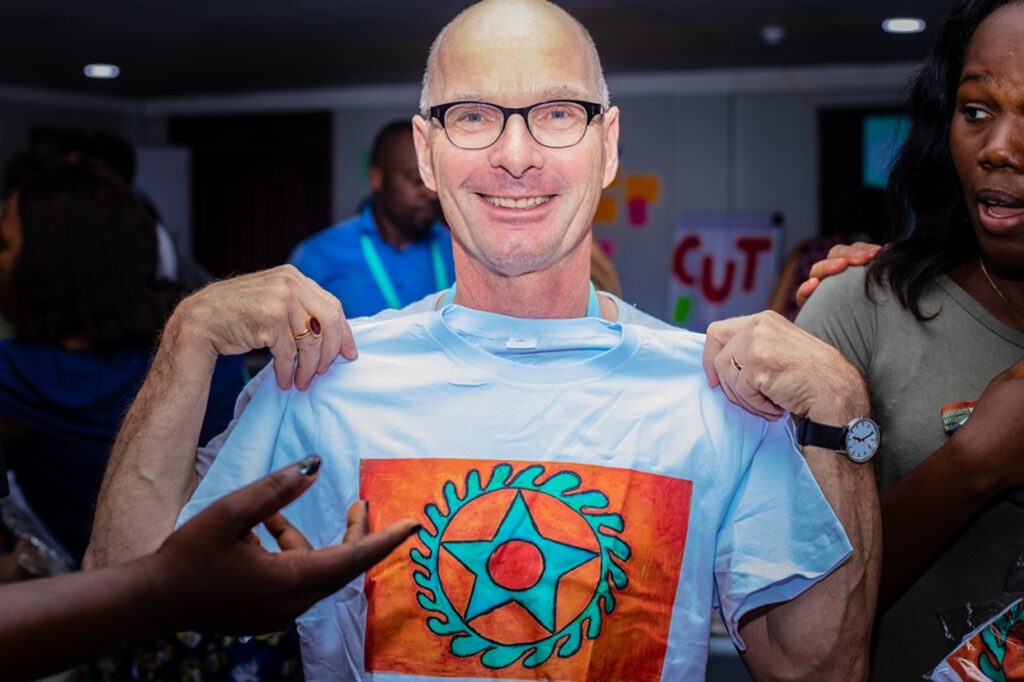Blog
The Colours of Inspiration: Raising the Flag of the GDL
Can an artwork created by a group of about 60 people kick off a process of inspirational thinking on a high-level diplomatic question?
Flags envision values, dreams and our understanding of how we connect as a society. This is what came to my mind while preparing for the first of this year’s two Global Diplomacy Labs, which was to be held in Accra, Ghana, in June. The topic of this year’s Lab was Africa’s Demographic Dividend, and our challenge holder, the German Federal Foreign Office, had asked us to think about key levers such as education, health care and policy making which positively influence demographic and economic development. The issues at hand seemed challenging and quite abstract. Together with Ivana Petrov, my colleague on the elected advisory GDL board, I discussed several questions: how can we kick off an intensive exchange on what we think and feel as GDL members about the topic of this year’s Lab? How can we make the abstract more concrete? How can we start to align our understanding and, last but not least, what is our identity, what holds us together as a group?
Thinking about these issues, I came up with the flag exercise “The Colours of Inspiration”. The goal was to connect the approximately 60 Lab attendees at the beginning of the Incubator Lab, to encourage them to get to know each other and to exchange their ideas and understanding in a creative and playful way. I sent the concept to GDL member, Firmin Adjahossou, our host, to discuss it. We thought about wild ideas such as taking the design of the flags as an exhibition to the reception at the German Embassy, hoisting the flag design as a real flag at a prominent place, t-shirts… ideas were there. What we didn’t expect was that all those dreams would become true in the end. We handed over the proposal to the preparation team and had a go. While I finalised the flow of the exercise, Firmin started to organise what we needed in Accra to make it happen. With the great support team, Jean Marie Dodo and his crew, everything was well prepared when I arrived in Accra, including a whole selection of fabrics to sew the flag and a professional tailor.
Starting the Lab in Accra with a bus tour, we arrived at the Dubois Centre for Pan-African Culture. After some welcome addresses and an icebreaker, we were ready to start the flag exercise. As I introduced the task, I saw some sceptical faces that seemed to be asking: are we artists – can we draw? However, after a short moment to digest the instructions, the groups enthusiastically started working at their tables. I observed different ways to approach the task: while some groups started with a discussion and a list of keywords, some drew personal designs of flags first, and others searched for graphic designs. There was a broad range of options in the room on how to organise the creative flow. Every table was energetically engaged in discussing the topic and in finding an appropriate idea to visualise what the GDL is all about. Soon we saw the first designs: there was a variety of colours, breath-taking compositions and great graphical drafts. Not more than one graphic element and three colours were allowed in the final design. The tension in the room rose as we aimed for a final presentation of all designs and the selection of the final flag. After 90 minutes we had 12 amazing designs and encouraged the audience to vote for their favourite by applauding. Two groups cheered like hell and drew the audience in. It was a head-to-head decision. Finally, we had a winner: an African symbol for transformation in an orange colour that gives the design powerful energy. As experienced artists were in the group and knew how to handle the painting material and the composition, the flag was ready to pass into the hands of Olivia, the local tailor we had hired.
The next day brought more intensive insights to the 10th Lab’s topic and ended at the residence of the German Ambassador, Christoph Retzlaff. I was both nervous and curious to discover whether the flag would be ready for presentation. The reception started with a welcome address by Christoph Retzlaff and a short interview with the key GDL stakeholders. After the speeches, Jean Marie Dodo tapped me on the shoulder and asked me to turn around. I was amazed. The flag was gently flying on a flag-pole at the bottom of the garden. “How did you make it happen?”, I asked him. The answer: Olivia, the tailor, had worked on the flag the whole day. The rest was simple: the GDL team had asked the Ambassador if they could hoist the flag, and he agreed. Normally there are lots of regulations for flags being hoisted at the German Embassy regarding symbols like this one. But the team was very compelling – a good example of trying out and reaching out for the best. As the design was so wonderfully translated into the “real thing”, a flag of 180 x 250 cm, all participants saw the beauty and the potential of its meaning – transformation. We all celebrated it with a flag hoisting ceremony accompanied by a dance session.
Could it get any better? Yes! GDL member Marty Castro from Chicago was so thrilled about the flag that he ordered a second one. Apart from that? We all received t-shirts emblazoned with the flag design at the end of the Incubator Lab.
About the author:
Jörg Reckhenrich is an artist reflecting on the human condition and positive psychology in his art projects and he loves to combine intensive reflecting on art with coaching sessions, focusing especially on personal growth, writing articles and teaching on creative leadership.
Published on July 19, 2019.
Photo credit: Jean-Baptiste Hounsou
